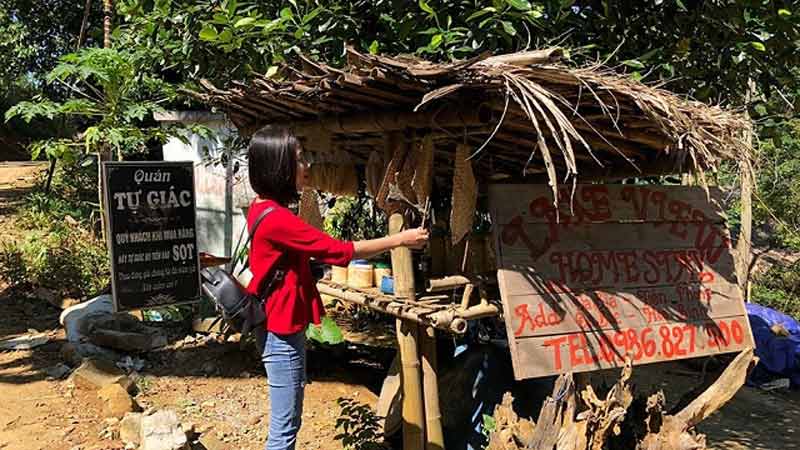


The bamboo-structure frame and thatched roof shops appear as easy-to-spot roadside huts with products on sale including home-grown vegetables, fruits, and specialties.
According to locals, this kind of shop was first established in Da Bia around two decades ago and it has resumed in the last couple of years. They first served as trading venues among local households. Families place their home-grown vegetables, fruits and chickens at the shops; buyers set their own prices for the products and leave money in the basket provided.
These shops have been widely known since Da Bia became popular among tourists.
The bamboo-structure frame and thatched roof shops appear as easy-to-spot roadside huts with products on sale including bamboo shoots, pickled bamboo, handmade bamboo fans, potaoes, and guavas.
There is a handwritten price list for these items, mostly ranging from VND 10,000 to VND50,000, with the most expensive item being a jar of pickled bamboo shoots at VND100,000. There are four self-aware shops in Da Bia, most of them selling agricultural products and specialties such as vegetables, fruits, dried bamboo, and homemade baskets and fans.
At the end of the day, buyers come to collect their money. As the products belong to different buyers, they must check which of their products have sold and collect the exact amount of money. The trading brings a little joy for both buyers and sellers who are neighbours in the village. The self-aware shops also represent mutual trust and respect among locals.
Dinh Thi Trang, a Da Bia villager, said that the self-awareness shops not only help local households to consume their home-made products, they also attract much interest from visitors.
Locals in Da Bia earn their living through agricultural farming and fishing on lakes. In recent years, local households have engaged in developing community-based tourism, contributing to promoting the village among visitors.
Most tourists to the self-awareness shops are excited and surprised at the model, they also suggest that shop owners add more to the shelves, such as brocade products, traditional cakes and decorative items of Muong ethnic group.
Community-based tourism projects have turned Da Ba into a hotspot on Hoa Binh Province’s tourist map. Visitors to Da Bia can admire the bucolic beauty of a mountainous village, explore unique culture of the Muong ethnic group, and shop at stores without sellers.